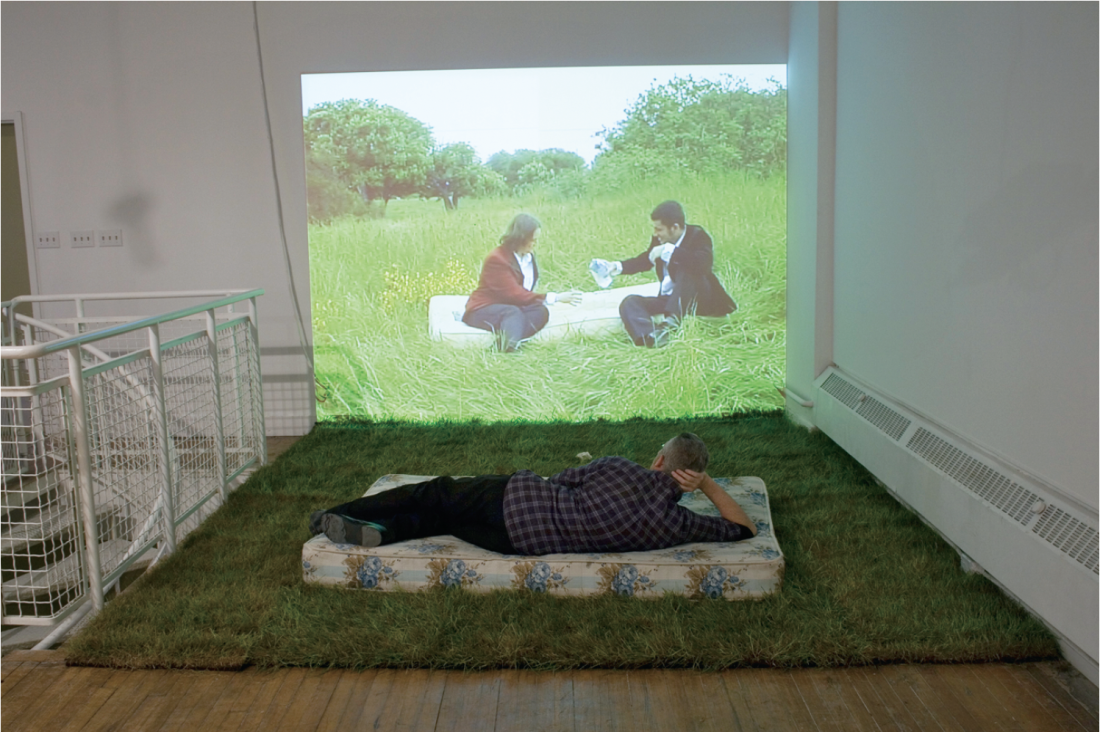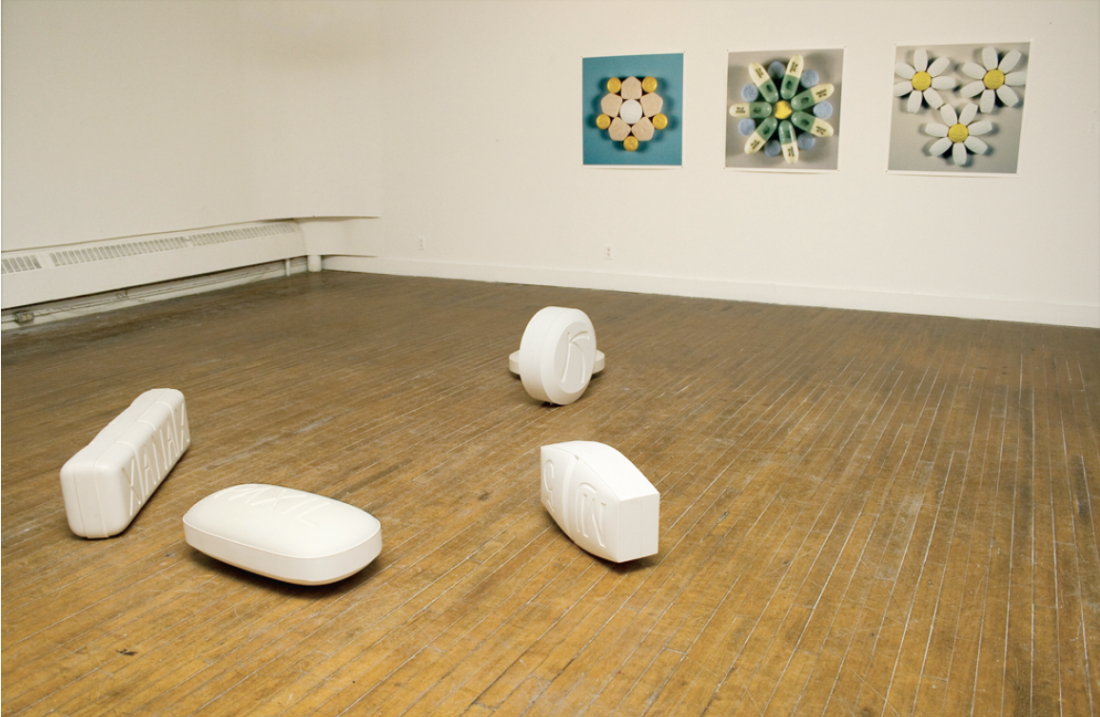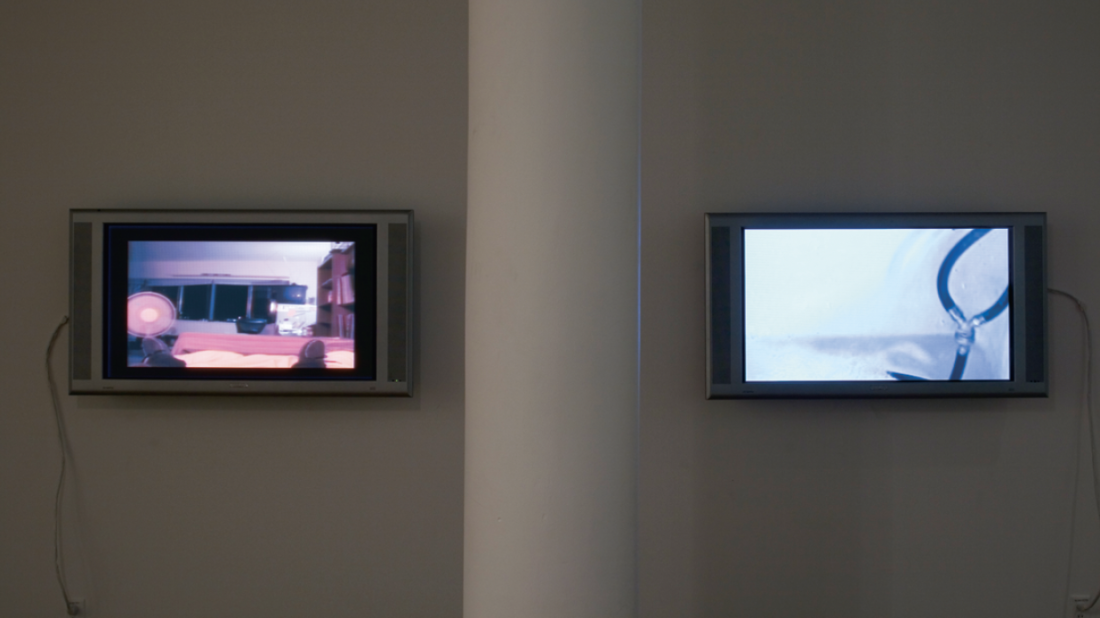“When the Mood Strikes Us ...”
Curated by JJ Kegan McFadden, “When the Mood Strikes Us …” is a conceptually solid and enticing little group exhibition of mature work. It toys with the poetics and politics of mind-altering drugs or, as the ancient Greeks called medicinal substances, pharmakon. I use the latter term because its indeterminate meaning—which, according to Derrida, includes “remedy, poison, potion, recipe, charm, medicine, spell, die, color and paint”—evokes the expanse of interpolated interpretations performed by the compelling works in this unpretentious show.

Abbas Akhavan and Marina Roy, Victoria Day (Bombay Sapphire), 2002, video projection, sod, mattress, 41 minutes.
Recreational drug use is typically associated with counter- or sub-cultural lifestyle clichés— rich-girl movie stars, street-kid runaways and self-destructive bohemians, among others. However, in Colleen Wolstenholme’s work, Spill, legal drug trafficking of the mainstream corporate kind looms large, literally as well as metaphorically. A scattering of body-sized pills, painstakingly cast or carved in ghostly white plaster, rests on the gallery’s honey-coloured hardwood floor. Designer-smart corporate logos— Xanax, Dilaudid, Paxil, Laratine, and BuSpar—are etched into the pristine, skin-smooth surfaces of these breathtakingly gorgeous objects. Modernism—that unholy alliance of science as progress, aesthetics as religious transcendentalism, and materialism as utopianism—lives on by way of consumerism, the pharmakon that defines 21st-century North American culture.
Alternately, in Paul Butler’s single channel videos, Steaks N Blunts, 1997, and Smoking in Bed with Your Shoes On, 2008, slacker hedonism and suburban boredom converge. McFadden astutely chose to present these two works—Butler’s first video and his most recently produced video— on identical monitors installed in close proximity to one another, which makes them they read like a diptych of sorts. Their diffused, hypnotic tone points to passive (aggressive) non-participation as a viable political response and effective antidote to living in a profoundly disturbed social context.

Jeremy Shaw, One Single Hit White Clinical Acid (after Malevich, for Optimists), 2006, C-print, 36 x 36”.
As part of his ambitious photo-based “Home Bodies” series, Larry Glawson has been baking, documenting and gifting pies since 2000. In the video projection, My Pie, 2008—an elusion to “sweetie pie” or “pie hole,” perhaps—a series of luscious, orifice-shaped cream and fruit-filled pastries expand, contract and swirl in a never-ending loop. The repetitive and insatiable nature of bodily cravings—and human desire itself— is wryly and lip-smackingly served up.
Jeremy Shaw’s One Single Hit White Clinical Acid (after Malevich, for Optimists) is a seductive white on white C-print of a substantially enlarged quarter-inch square of blotter acid. Part of an ongoing body of work that explores youth subcultures, the image ambivalently collapses the hierarchical divide that distinguishes the pursuit of sublime states by canonized modernist artists from the aspirations of drug-experimenting youth. Nearby, Shaw’s Anti-Psych (Total Backlight), 2005, a single blackened and broken light bulb dangles menacingly from the ceiling. It refers to the inhalation of “crystal meth,” a deadly poison that’s led far too many youth down the dead-end path to a permanent blackout.

Colleen Wolstenholme, in front: Spill, 1997-2000, plaster carvings, dimensions variable; behind: Pill Mandala, 1999, digital prints, 33 x 33” each.
In Abbas Akhavan and Marina Roy’s collaborative video installation Victoria Day (Bombay Sapphire), the artists update Manet, performing a “liquid luncheon on the grass.” With the ocean as backdrop, a lush west-coast park setting and a skuzzy mattress providing ground-level seating, formally attired Abbas and Marina consume two bottles of fine English gin from teacups. The convivial performance ends with a total blackout when Marina stumbles towards the camera and shuts it off. This witty, politically astute installation raises urgent questions about the lingering effects of colonization and middle class entitlement, about who is (and isn’t) accorded the privilege of imbibing and socializing, unpoliced by the public’s judgmental and voyeuristic gaze.
Ostensibly, states of consciousness, chemically induced or otherwise, represent the most private, personal and “unique” aspect of our lived experience. Yet the beating of our hearts, the flow of blood in our veins, our visual and auditory perceptions and our emotional states—the most intimate of our inner experiences— can be altered so dramatically by miniscule portions of certain substances that subjectivity itself is called into question: we no longer “feel like ourselves.” Which may be precisely the point.

Paul Butler, on left: Smoking in Bed With Your Shoes On, 2008, single-channel video, 3 minutes, 21 seconds; on right: Steaks N Blunts, 1997, single-channel video, 5 minutes, 32 seconds. Courtesy Video Pool Media Arts Centre.
But the story doesn’t end there. As the works in this exhibition so compellingly demonstrate, our beliefs are as integral to our subjectivity as our physiological responses. Socially produced, politically invested interpretations of socio-economic class, sexual orientation, generation, age and gender routinely shape and transform our perceptions and desires as dramatically as any chemical hit. Interpretations may work their effects at a much slower pace, but for better or for worse, these effects last much longer.
Which is to say that “When the Mood Strikes Us …” addresses nothing less than the slippery but politically potent and expansive space that connects inner and outer, self and other, subjectivity and consensual reality, belief and desire. It slyly performs how interpretation—which includes cultural production in all its forms—works this space, conjoining one state to another. ■
“When the Mood Strikes Us …,” curated by JJ Kegan McFadden, was exhibited at platform: Centre for Photographic + Digital Arts in Winnipeg from September 12 to October 24, 2008.
Sigrid Dahle is a Winnipeg-based curator and art writer.

